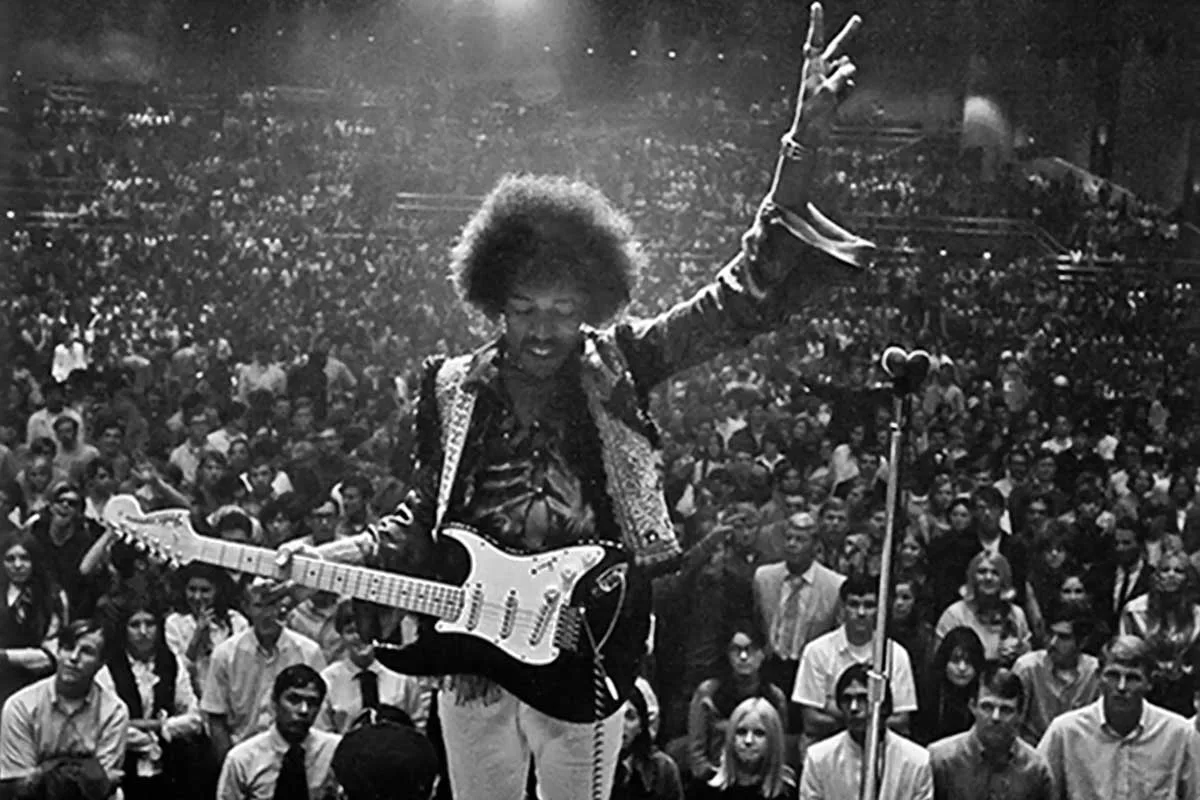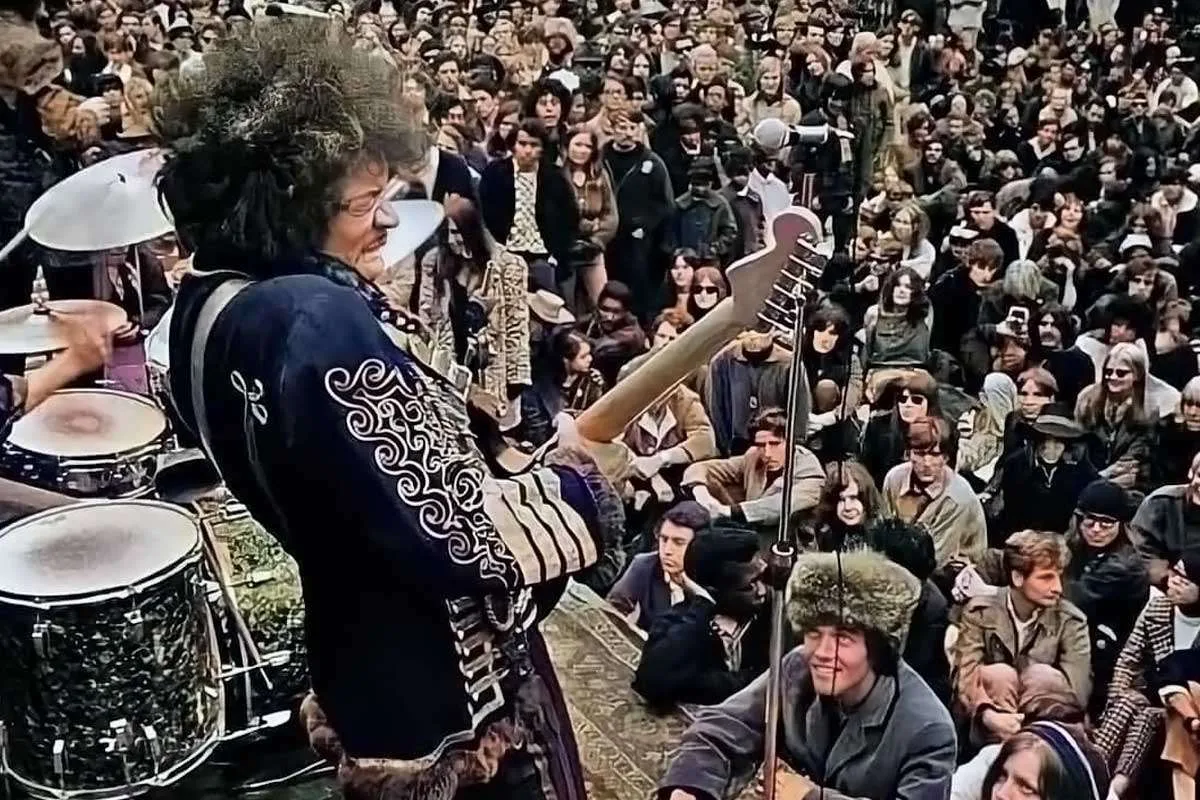Jimi Hendrix’s journey to guitar mastery was as unconventional as his playing style. But how did Jimi Hendrix learn guitar? He was an autodidact, meaning he was entirely self-taught, developing his skills through relentless practice and an innate passion for music.
Growing up in a challenging environment, he found solace in the blues, drawing inspiration from legends like Muddy Waters and B.B. King. At around 15, he acquired his first guitar and immersed himself in learning by ear, watching other musicians, and experimenting on his own.
His left-handed playing, combined with his innovative approach to technique and tone, helped shape a sound that was entirely his own, redefining what was possible on the electric guitar.
Key Takeaways:
- Jimi Hendrix was entirely self-taught, learning guitar through relentless practice, experimentation, and an innate passion for music.
- He trained his ear by playing along with records from blues legends like Muddy Waters and B.B. King, shaping his musical foundation.
- Without formal lessons, Hendrix learned by watching other musicians, picking up techniques, and adapting them into his own unique style.
- His left-handed playing and innovative approach to sound, including feedback and distortion, pushed the limits of what the electric guitar could do.
- Hendrix’s journey proves that dedication, curiosity, and fearlessness in experimentation are key to mastering the guitar, even without traditional instruction.

Early Life and Initial Exposure to Music
As you explore the early years of Jimi Hendrix, you’ll uncover the roots of his profound musical journey. From a modest family background to his initial strumming on a one-string ukulele, Hendrix’s raw talent was shaped by rock and blues legends.
Family Background and Childhood
Jimi Hendrix, born Johnny Allen Hendrix, was raised in Seattle by his father, Al Hendrix. Despite the family’s financial hardships, his father recognized Jimi’s early interest in music. The struggle and love within his family played a crucial role in forming Jimi’s emotional depth, which would later be expressed through his music.

First Encounter with String Instruments
Your introduction to Hendrix’s musical endeavors begins with a discarded ukulele, which he found while helping his father with a side job. Although it only had one string, young Hendrix learned to play by ear, replicating the tunes he remembered from his mother’s records. This one-string instrument became the unlikely launchpad for his legendary guitar skills.
Influence of Early Rock and Blues Artists
Your understanding of Hendrix’s style is incomplete without acknowledging the influence of Elvis Presley, Little Richard, and Muddy Waters. These artists’ records were Hendrix’s early window into rock and blues, serving as both inspiration and a foundation for his later revolutionary sound. It was these roots that fueled his passion and set the stage for his ascent in the music world.
Initial Steps in Learning Guitar

Acquisition of First Guitar
Jimi Hendrix’s initial encounter with a guitar was pivotal, beginning a legendary career. Like you might, he found his first love in an acoustic guitar, an affordable option for many beginners. It’s often the starting point due to its wide availability and the foundational techniques it can teach.
Self-Taught Learning Process
Hendrix was predominantly self-taught, a testament to his natural talent and determination. You, too, can begin this journey through self-education, diving into practice sessions, often imitating songs and styles of admired artists, slowly forming a unique sound. Essential resources include chord books and recordings, which allow you to dissect and absorb various playing styles.
Development of Fundamental Skills
Fundamental skills involve more than just practice; it’s about honing your technique and understanding the instrument:
- Tuning: Learning to properly tune your guitar is essential. Whether you have an acoustic or a Danelectro, familiarize yourself with the pitches and ensure each string is correct for accurate sound production.
- Techniques: Basic techniques include strumming, fingerpicking, and bending strings. Each requires consistent practice to master.
- Chords: Begin with learning simple chords; they are the building blocks of songs and will be crucial for your growth as a guitarist.
As you follow these steps, remember that consistency is key, echoing Hendrix’s own path to becoming one of the most influential guitarists in history.
How Jimi Hendrix Played and Tuned His Guitar
Jimi Hendrix’s revolutionary approach to the guitar was a key factor in shaping his iconic sound.
From the way he strung his instrument to his unique tuning preferences, every aspect of his playing contributed to his signature style.
His unconventional techniques not only set him apart but also influenced generations of guitarists.
When Did Jimi Hendrix Start Playing Guitar?
So, when did Jimi Hendrix start playing guitar? He began his journey around the age of 15 when he acquired his first acoustic guitar.
Without formal lessons, he taught himself by playing along with blues and rock records, gradually developing his skills through observation and relentless practice.
This early dedication laid the foundation for his groundbreaking approach to the instrument.
How Did Jimi Hendrix String His Guitar?
As a left-handed guitarist in a predominantly right-handed world, Hendrix had to adapt his instrument to fit his needs.
How did Jimi Hendrix string his guitar? Instead of using a left-handed guitar, he took a standard right-handed Fender Stratocaster, flipped it upside down, and restrung it so that the thickest string was still at the top.
This unorthodox setup influenced the tension and feel of the strings, contributing to his distinct tone and fluid playing style.
How Did Jimi Hendrix Tune His Guitar?
Another key element of Hendrix’s sound was his tuning. How did Jimi Hendrix tune his guitar? He frequently tuned his Stratocaster down a half step to E♭ standard (E♭–A♭–D♭–G♭–B♭–E♭).
This lower tuning gave his playing a warmer, heavier tone and made it easier to bend notes, allowing for greater expressiveness in his solos. Combined with his mastery of feedback and distortion, this tuning became an essential part of his legendary sound.
Formation of the Guitar Virtuoso
Jimi Hendrix’s journey to becoming a guitar virtuoso involved intense dedication to mastering his instrument and pushing the boundaries of what was sonically possible. His evocative use of the electric guitar and exploratory techniques set a new standard in guitar playing.
Mastering the Craft of Guitar Playing
Your understanding of Hendrix’s skill starts with his complete immersion in the craft of guitar playing. Tuning peg adjustments and precise finger placement became second nature as he honed his ability to meld rhythm and melody. This mastery was not just about playing chords; it was about making the guitar an extension of his own expression.
Experimentation with Sounds and Techniques
Hendrix’s status as one of the greatest guitarists was not just due to his ability to play; it was his experimentation with sound that truly set him apart. He pushed the electric guitar to its limits, experimenting with feedback, distortion, and techniques no guitar player had made mainstream before. This innovative approach to sound and technique was pivotal in the evolution of the craft, showcasing a blend of raw energy and finely-tuned control.
Learning from Hendrix’s Path
Jimi Hendrix revolutionized the guitar with his unprecedented approach to the instrument. His journey from a passionate novice to a legendary rock guitarist highlights the importance of grit and determination in achieving musical success. Explore how you can start somewhere and nurture your natural talent into your own style, inspired by Hendrix’s techniques.
Approaching Guitar Learning Inspired by Hendrix’s Techniques
When you decide to learn the guitar, consider how Jimi Hendrix approached his instrument: with a relentless curiosity and a fearless attitude. Be bold in experimenting with different pitch and tones, knowing that grit is as vital as the guitar itself in your journey to becoming a skilled guitarist. Hendrix’s guitar was a constant companion—immerse yourself similarly and become attuned to the nuances of your instrument, embodying the spirit of rock where each string’s vibration is a testament to hard work carved into melody.
Related: Who inspired Jimi Hendrix
Developing Your Own Style
Your guitar is not just an instrument; it’s an extension of your personality. Use Hendrix’s path as inspiration—he incorporated elements of blues, rock, R&B, and soul to create a sound uniquely his own. Combine this inspiration with your personal musical influences to develop a style that resonates with who you are. Remember, it’s not just about mimicking Hendrix’s grit or his flair for dramatic pitch bends and soulful vibrato, but about channeling your determination to find your voice within the music you create.
By nurturing your talent and persisting through the challenges, you honor the legacy of Jimi Hendrix—not through imitation, but through your own musical success and the hard work you dedicate to the craft of guitar playing. Start your journey, find your rhythm, and let the world hear what you have to offer.
